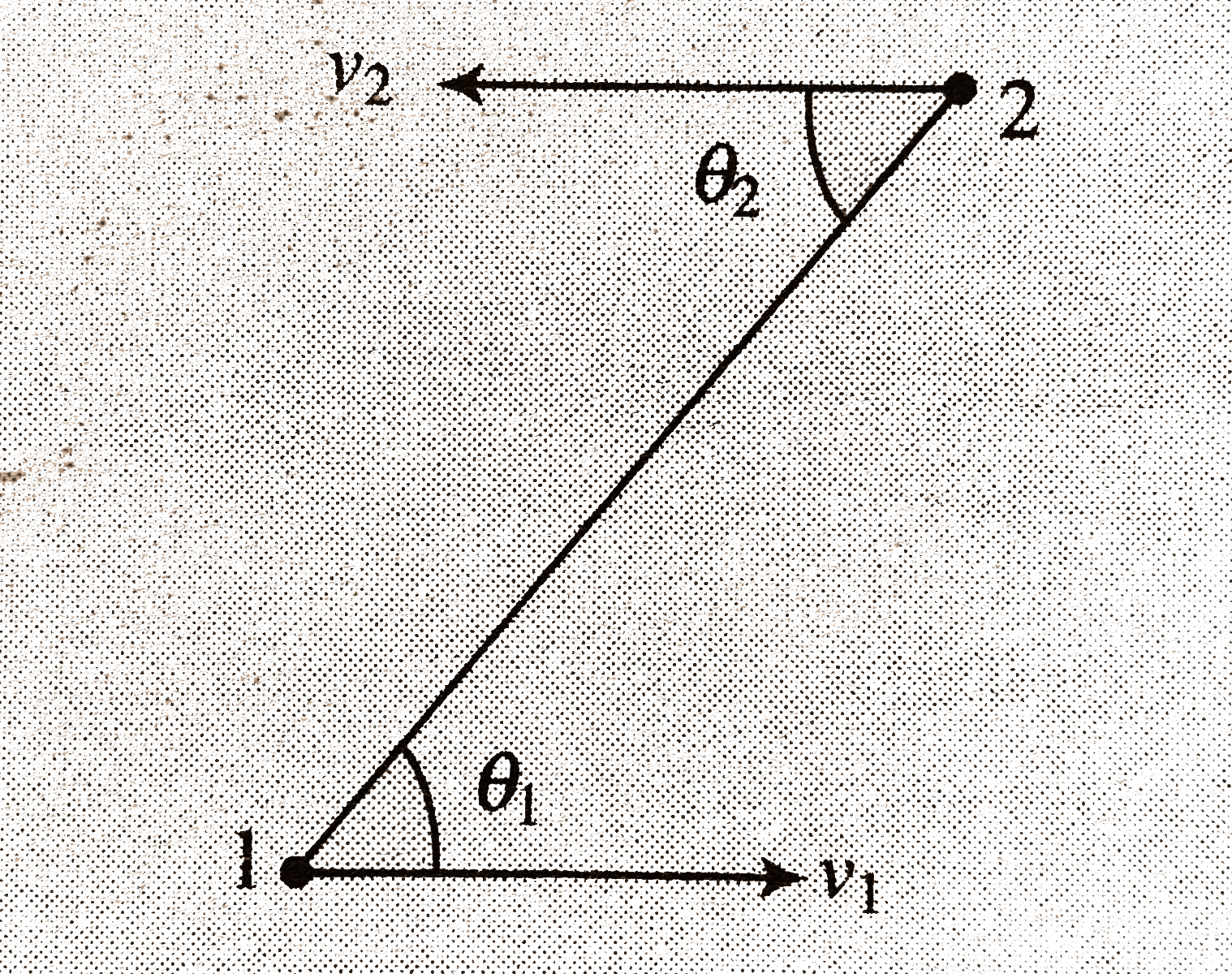Two particles, 1 and 2, move with constant velocities v1 and v2. At the initial moment their radius vectors are equal to r1 and r2. How must these four vectors be interrelated for the particles to collide?
The correct Answer is:(r1−r2)/|r1−r2|=(v2−v1)/|v2−v1|
To determine how the radius vectors and velocities of two particles must be interrelated for them to collide, we can follow these steps:
Step 1: Define the positions of the particles
Let the position of particle 1 at time t be given by:
r1(t)=r1+v1t
And for particle 2:
r2(t)=r2+v2t
Step 2: Set the positions equal for collision
For the two particles to collide, their positions must be equal at some time t:
r1+v1t=r2+v2t
Step 3: Rearrange the equation
Rearranging the equation gives:
r1−r2=(v2−v1)t
Step 4: Express time t
From the rearranged equation, we can express time t as:
t=r1−r2v2−v1
This equation indicates that for the particles to collide, the vector difference in their initial positions must be proportional to the vector difference in their velocities.
Step 5: Conditions for collision
For the above equation to yield a valid time t, the following conditions must be satisfied:
1. The vector v2−v1 should not be zero (i.e., the velocities must be different).
2. The direction of r1−r2 must be the same as the direction of v2−v1.
Conclusion
Thus, the relationship between the vectors for the particles to collide can be summarized as:
- The difference in their initial position vectors r1−r2 must be parallel to the difference in their velocity vectors v2−v1.
Let the position of particle 1 at time t be given by:
r1(t)=r1+v1t
And for particle 2:
r2(t)=r2+v2t
For the two particles to collide, their positions must be equal at some time t:
r1+v1t=r2+v2t
Rearranging the equation gives:
r1−r2=(v2−v1)t
From the rearranged equation, we can express time t as:
t=r1−r2v2−v1
This equation indicates that for the particles to collide, the vector difference in their initial positions must be proportional to the vector difference in their velocities.
For the above equation to yield a valid time t, the following conditions must be satisfied:
1. The vector v2−v1 should not be zero (i.e., the velocities must be different).
2. The direction of r1−r2 must be the same as the direction of v2−v1.
Thus, the relationship between the vectors for the particles to collide can be summarized as:
- The difference in their initial position vectors r1−r2 must be parallel to the difference in their velocity vectors v2−v1.
Topper's Solved these Questions
- BOOK - IE IRODOV, LA SENA & SS KROTOVCHAPTER - PHYSICAL FUNDAMENTALS OF MECHANICSEXERCISE - The Fundamental Equation Of Dynamics59videos
PHYSICAL FUNDAMENTALS OF MECHANICS
- BOOK - IE IRODOV, LA SENA & SS KROTOVCHAPTER - PHYSICAL FUNDAMENTALS OF MECHANICSEXERCISE - Laws Of Conservation Of Energy, Momentum And Angular Momentum82videos
PHYSICAL FUNDAMENTALS OF MECHANICS
- BOOK - IE IRODOV, LA SENA & SS KROTOVCHAPTER - OSCILLATIONS AND WAVESEXERCISE - Electromagnetic Waves, Radiation36videos
OSCILLATIONS AND WAVES
- BOOK - IE IRODOV, LA SENA & SS KROTOVCHAPTER - THERMODYNAMICS AND MOLECULAR PHYSICSEXERCISE - Transport Phenomena38videos
THERMODYNAMICS AND MOLECULAR PHYSICS
Similar Questions
Two particles, 1 and 2, move with constant velocities v1 and v2 along two mutually perpendicular straight lines toward the intersection point O. At the moment t=0 the particles were located at the distances l1 and l2 from the point O. How soon will the distance between the particles become the smallest? What is it equal to?
View SolutionTwo particles 1and2 move with velocities →v1 and →v2 making the angles θ1andθ2 with the line joining them, respectively. Find angular velocity of relative→1.
 .View Solution
.View Solution
Knowledge Check
- Question 1 - Select One
Two particle A and B, move with constant velocities →v1and→v2. At the initial moment their position vectors are →r1 and →r2 respectively . The condition for particles A and B for their collision is
A→r1×→v1=→r2×→v2B→r1−→r2=→v1−→v2C→r1−→r2∣∣→r1−→r2∣∣=→v2−→v1∣∣→v2−→v1∣∣D→r1.→v1=→r2.→v2 - Question 2 - Select One
Two particles A and B, move with constant velocities →v1 and →v2. At the initial moment their position vectors are →r1 and →r2 respectively. The condition for particle A and B for their collision is
A→r1−→r2=→v1−→v2B→r1−→r2∣∣→r1−→r2∣∣=→v2−→v1∣∣→v2−→v1∣∣C→r1.→v1=→r2.→v2D→r1×→v1=→r2×→v2 - Question 3 - Select One
Two particles are moving with velocities v1andv2 . Their relative velocity is the maximum, when the angle between their velocities is
AzeroBπ/4Cπ/2Dπ
Two particles AandB are moving with constant velocities v1andv2. At t=0, v1 makes an angle θ0 with the line joining AandB and v2 makes an angle θ2 with the line joining AandB. Find their velocity of approach.
 .View Solution
.View SolutionA closed system consists of two particles of masses m1 and m2 which move at right angles to each other with velocities v1 and v2. Find:
(a) the momentum of each particle and
(b) the total kinetic energy of the two particles in the reference frame fixed to their centre of inertia.View SolutionTwo point masses 1 and 2 move with uniform velocities →v1 and →v2, respectively. Their initial position vectors are →r1 and →r2, respectively. Which of the following should be satisfied for the collision of the point masses?
View SolutionTwo particles of masses m1,m2 move with initial velocities u1andu2. On collision , one of the particles get excited to higher level , after absorbing energy ε. If final velocities of particles be v1 and v2 then we must have
View SolutionTwo particles of mass m and 2 m moving in opposite directions collide elastically with velocities v and 2v. Find their velocities after collision.
View Solution

